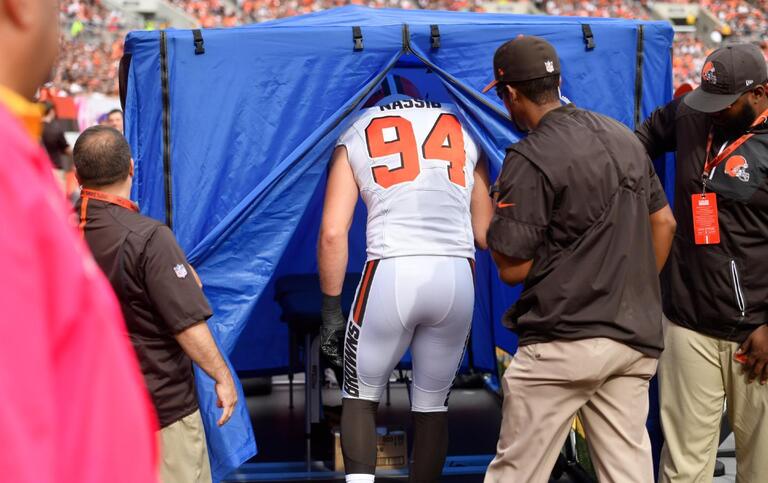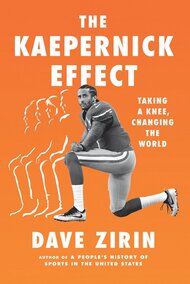Sports Media Has Forgotten About CTE Even After Player Deaths

Cleveland Browns player Carl Nassib enters the bue tent during an NFL football game against the New York Jets, in Cleveland. (David Richard / AP Photo)
The NFL season has been rife with tragedy—not that the league or its media partners have noticed.
The blue tent is now as much a part of NFL Sunday as the national anthem. It sits in full view on one sideline, and it’s where players are sent to be assessed for concussions after receiving a blow to the head. Their injury is then checked by an independent concussion evaluator—and thank God for this shred of progress. But the tent is also a symbol of what the league wants to obscure: We see players being treated and carted off for dislocated ankles, torn Achilles tendons, and twisted knees, yet concussion testing is now done away from the eyes of the fans. We watch players cry out in pain with compound fractures, but we rarely see the dazed looks, unsteady steps, or vomiting that can result from a traumatic brain injury.
The blue tent makes it seem like the NFL is taking care of an issue that had been dragged into the light by both off-field tragedies and a science-based movement of player advocates: that the repeated concussions endemic to football can cause Chronic Traumatic Encephalopathy (CTE). In recent years, the CTE discourse has mostly disappeared—as if the whole topic had been pulled into a blue tent. But CTE should still be at the center of discussions about the country’s most popular sports league.
So far in 2025, nine former and current NFL players under the age of 48 have died. Of those nine deaths, seven were the result of suicide, actions that signaled deep mental duress, or undisclosed reasons. A Nation overview of other major sports leagues—including the violent worlds of boxing and mixed martial arts, can’t find anything close to similar numbers elsewhere. Yet you’d barely know it. Media members who once predicted that our knowledge of CTE could endanger the sport are now more interested in the gambling experience of fans than the workplace safety of players.
While the media curiosity has died, the players are still suffering. CTE is associated with depression, drastic mood swings, and suicidal ideation. Players know this. Two legendary footballers—Hall of Fame linebacker Junior Seau and Chicago Bears safety Dave Duerson—shot themselves in the chest so their brains could be studied for CTE, which can only be conclusively diagnosed postmortem. This is why the family of former Cincinnati Bengals running back Rudi Johnson, who took his own life on September 23, have gone public with the fact that he was telling people that he was suffering from CTE. Players talk to one another, and they know that many of their former colleagues experience a combination of depression and erratic behavior that had not previously been part of their lives. This is why the family of Doug Martin, a 36-year-old Pro Bowler who just died in police custody after being arrested in an alleged home invasion, has announced that his brain will be tested for CTE. (It also sounds like yet another example of why we need ways to intervene in the mental health episodes of loved ones without involving the police.)
Impaired impulse control, depression, mood swings, and easy access to handguns become the ingredients for tragedy. There should have been a greater discussion in the media about CTE, violence, and mental illness when former high school running back Shane Tamura burst into the lobby at the NFL’s Park Avenue headquarters with an AR-15 earlier this year, killing four people. He later fatally shot himself in the chest, barricaded on the building’s 33rd floor. This, of course, garnered national coverage. But the media attention dissipated—particularly in sports media—when it was revealed that Tamura’s suicide note said he was driven to do this because he believed CTE was destroying his brain. His autopsy showed that he was correct. Tamura’s suicide note also references Terry Long, a former NFL player who was found to have CTE after he killed himself by drinking antifreeze in 2005.
Of course, mental health challenges can exist independently of traumatic brain injuries, and it is impossible to quantify how stigmas against psychiatric assistance in hyper-masculine sports might play into these deaths as well. Other attendant issues that plague ex-athletes like bankruptcy, substance abuse, and the disorientation of being “retired” at 28 years old should also be considered.
These discussions are not new. What is particularly disturbing, however, is how the traditional league watchdogs—like ESPN and the current iteration of the NFL Players Associations—are saying or doing so little.
When 24-year-old Dallas Cowboys player Marshall Kneeland died by gunshot suicide last week, the day after he scored his first touchdown, the Dallas media clamored to understand the role that CTE and head injuries may have played in his suicide. But CTE was not mentioned in ESPN’s coverage. It also wasn’t mentioned either by the media or teams in tributes to Kneeland held before Monday night’s national telecast of the Cowboys game against the Las Vegas Raiders.
It is complicated and heartbreaking to try to divine why a young football player would kill himself, but such a tragedy still demands rigorous reporting and analysis, which hardly exists in sports media now. A decade ago, when CTE burst into view, ESPN would regularly have televised programming about the latest death or lawsuit. Most of that was funneled through their now-canceled award-winning daily journalism program Outside the Lines. Today, with more online video NFL coverage than ever, CTE discussions are absent. Many of the old journalists have been replaced by loquacious, media-trained ex-players who specialize in talking a lot and saying little of substance and opining more about betting lines than what might be happening “outside the lines.”
According to a Nation overview, from August to November 2024, ESPN published at least seven articles—excluding neutral injury reports—that dealt with the devastating effects of concussions. This year, during those same months, The Nation could identify only one such article, even with this series of tragic deaths.
“It is frustrating that there is less media coverage and investigative reporting on CTE than there was a few years ago,” said Chris Nowinski, CEO and cofounder of the Concussion Legacy Foundation. “The NFL has strategically built business relationships with media organizations.”
He added that “with shrinking print media, there are few places that can invest in the coverage of CTE. That coverage thus far has resulted in football becoming safer, and more resources being provided to struggling football families. Many of those changes and services were inspired by investigative reporting, and I worry that without the media, progress will slow or even reverse.”
Sure enough, a former ESPN journalist told me that the fact that the NFL now owns 10 percent of ESPN could be blunting the network’s zeal to investigate the ugly underbelly of the league. The self-proclaimed “Worldwide Leader in Sports” matters, because its coverage often determines the focus of other sports networks, all trying to feed in its wake.
As for the NFL players’ union, it has been a rudderless, scandal-plagued shell since the exit of DeMaurice Smith as executive director. “The horrifying events of recent months demand serious attention from every stakeholder in this business,” Smith said to The Nation. “As executive director, I believed it was essential to love players more than the game—and to treat football for what it is: a dangerous workplace that can damage both body and mind. Research, safety protocols, treatment, intervention, and medical care are all indispensable, but so is the professional and collegiate duty to remain unsatisfied with where they stand today.”
In contrast, when The Nation contacted the NFLPA, it said in a statement:
In all that we do, our union’s main priority is to support players as people who go to work every day and have an identity beyond football. We also understand that they are men who navigate unique circumstances during and after their football careers. That’s especially true when it comes to their emotional well-being. Our mental health resources are designed to provide a trusted and necessary source of support for our player members along their journey.
You can read that five times and wonder what it has to do with anything. At least the NFLPA got back to The Nation—the NFL and ESPN did not respond to requests for comment. The saying that “silence is violence” has never felt so appropriate. But there are only so many bodies that they can lead out of view, away from prying eyes and into the blue tent, until the public once again reckons with the human cost of the country’s true national pastime.
More columns ⇒
Support the Work
Please consider making a donation to keep this site going.
Featured Videos
Dave on Democracy Now!

